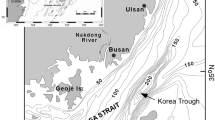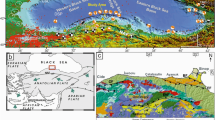Abstract
The shelf between Tekirdağ and Şarkoy, NW Marmara Sea, is controlled by a major fault system, the Ganos Fault (GF), which is claimed to be the source of the 7.3 (Ms) earthquake in 1912. The effect of GF and global sea-level changes on of the shelf between Tekirdağ and Şarkoy was discussed on the basis of seismic-stratigraphic data. Two main units (U1, U2) and three para-sequences (U1a, U1b and U1c) were determined. The para-sequences (U1b, U1c) are of fluvial origin and are mainly controlled by the sea-level fluctuations. The sea-bottom morphology and the thickness of the resulting seismic-stratigraphic units must have been controlled mainly by the GF. Moreover, the GF also controls the elevation differences between the wave-cut terraces along the Tekirdag-Şarkoy self and the others in the Marmara Sea.
Access provided by Autonomous University of Puebla. Download conference paper PDF
Similar content being viewed by others
Keywords
1 Introduction
The Marmara Sea is connected to the Black Sea and the Mediterranean Sea via the Straits of İstanbul and Çanakkale (Bosphorus and Dardanelles), respectively. The water exchange between the Marmara Sea and the Mediterranean has been cut off and the shelf areas of the Marmara Sea were sub-aerially exposed during the Last Glacial Maximum (LGM), under the control of the sill depth in the Strait of Canakkale (Aksu et al. 1999; Cagatay et al. 2009). The connection was re-established with transition to warming period (Cagatay et al. 2009). The post-glacial sedimentary successions deposited on the northern shelf are generally composed of thin sediments that overly the acoustic basement (Aksu et al. 1999; Cagatay et al. 2009; Nasıf et al. 2019; Vardar et al. 2018). The coarser sediments, however, derived from erosion of tectonic highs, some terrestrial inputs and new hydrodynamic conditions. High-resolution seismic profiles concerning the sedimentary successions from the LGM to the recent at the northern shelf are scarce and a number of available profiles are not that sufficient to explain the possible formation and evolution conditions. Karakilcik and her colleagues, for example, recently used Uniboom seismic sections and outlined three units above the acoustic basement (Karakılçık et al. 2014). Later, two different research teams collected new data sets and defined additional seismic units (Nasıf et al. 2019; Vardar et al. 2018). They explained these units as isolated lakes, lacustrine deposits and deltaic successions, which implied external conditions spatially variable along the shelf. Nevertheless, there are still debates on the depositional history of the northern shelf and their relation with the sea/lake-level fluctuations in the Marmara Sea, which run in parallel with new data sets.
The shelf between Tekirdağ and Şarkoy, NW margin of this intra-continental marine basin, is mainly affected by the Ganos Fault (GF). It is a major fault system directly related with the North Anatolian Fault system.
With the help of seismic-stratigraphic analysis of a new high-resolution seismic data set gathered nearshore and offshore the GF, this study focussed on the role of the GF in the late Quaternary offshore deposition under variable water level changes.
2 Materials and Methods
We have collected 450-km of high-resolution single channel CHIRP seismic data in April 2019 (Fig. 1a), and interpreted them based on the fundamental principles of sequence stratigraphy (Posamentier and Vail 1988). Bathy 2010P™ Chirp sub-bottom profiler and bathymetric echo sounder (2–8 kHz) were used to obtain much detailed sub-bottom survey capability. We used the freeware Kogeo Seismic Toolkit for basic data processing methods, such as band-pass filtering (10–15; 1750–1900 Hz) and gain adjustment. The processed profiles were transferred and interpreted with Kingdom Suite® (version 8.5; donated by “Seismic MicroTechnology”). For depth conversion, we used the velocity of 1500 m/s for the seawater.
3 Results
3.1 Seismic Stratigraphy
The seafloor bathymetry deducted from the data (Fig. 1a) indicates that the shelf is relatively wide at the offshore sectors between Tekirdağ–Kumbağ (~10 km) and Gaziköy–Şarkoy, if compared to the sector Kumbağ-Gaziköy (<500 m). We outlined two main seismic units (U1 and U2), separated by an erosional unconformity (the sequence boundary SB; Fig. 1 b, c, d). Unit U1 includes all the sediments deposited from the LGM to the present, which consist of three para-sequences; U1a, U1b and U1c. U1a is characterized by weak, continuous and parallel internal reflections while U1b is represented by roughly parallel to progradational sigmoidal reflections downlapping on the SB. As for U1c, it is characterized by aggradational clinoforms, toplapping to the overlying erosional surface (Fig. 1 b, c, d). Unit U2 is the acoustic basement, and it is characterized by high-angle internal reflections throughout the study area (Fig. 1 b, c, d). In this context, the SB, separating U1 and U2, is the sub-aerially exposed erosional surface. It is just below the thin post-last glacial deposits on the outer shelf, and nearly concordant with the recent bathymetry.
4 Discussion
The total thickness of the units U1a and U1b is nearly 20 ms at the nearshore areas, implying high rates of sediment transportation. The units become thinner towards the shelf break. The unit U1 (Fig. 1b) is rather thin above the terraces. This can be explained by the fact that the deposits might have been eroded by subaerial effects during the relative sea-level still stands or they have been transported with the longshore currents, a well-known hydrodynamic feature of the region. The units reach their maxima (~35 ms) between Gazikoy and Kumbağ. This is believed to be directly related with the activities of GF. The thickness of U1a is higher in the northern part of the GF, which may be directly related with the activities of this fault and its northward slope (Fig. 1c).
The wave-cut terraces at the northern shelf of Marmara Sea were given as −65, −87, −93 and −102 m in Cagatay et al. (2009), −95, −87 m (Posamentier and Vail 1988), − 65 m (Nasıf et al. 2019), −63 m for the shallowest terraces in Alp et al. (2018). The depth of the correspondent terraces, related with the relative still stands, are −49 m, −60 m in the study area. The difference indicates that the tectonic uplift was caused by the GF. The U1b sigmoid depositions between Tekirdağ and Kumbağ is progradational, the ascending trajectories of rollover points can be correlated with sea-level rise during the clinotheme development, and delta front is at 43 ms bsl. Therefore, the U1b unit was probably deposited during the Transgressive System Tract (TST), like U1a. The eroded top surface of the U1c implies the unit is subaerial exposed during the LGM, so the unit was deposited during the falling stage (FFST) and low stand system tracts (LST).
5 Conclusions
The distribution of the seismic units above the erosional surface SB and their stratigraphic characteristics indicate that the sedimentary units on the shelf are mainly sourced by fluvial, terrestrial and marine deposits, starting from the LGM to the present and controlled by the water level changes in the Marmara Sea. However, the thickness of the units, as well as the width of the shelf area (e.g. the sector Kumbağ-Gaziköy), have been controlled mainly by the GF. Erosion along the slopes and deepening of the E-W-trending basin were controlled by the dominant tectonic regime in the region. In addition to controlling the external shapes of the units, the tectonic regime controls the internal reflections and their terminations in the stratigraphic units in accordance with the sea-level variations. The elevated terraces in the study area, shallower than the others along the northern shelf, must have been due to the regional tectonic uplift along the GF.
References
Aksu, A.E., Hiscott, R.N., Yasar, D.: Oscillating Quaternary water levels of the Marmara Sea and vigorous outflow into the Aegean Sea from the Marmara Sea-Black Sea drainage corridor. Mar. Geol. 153, 275–302 (1999)
Alp, H., Vardar, D., Alpar, B., Ustaomer, T.: Seismic evidence for change of the tectonic regime in Messinian, northern Marmara Sea Turkey. JAES 151, 40–53 (2018)
Cagatay, M.N., Eris, K., Ryan, W.B.F., Sancar, U., Polonia, A., Akcer, S., Biltekin, D., Gasperini, L., Gorur, N., Lericolais, G., Bard. E.: Late Pleistocene–Holocene evolution of the northern shelf of the Sea of Marmara. Mar. Geol. 265, 87–100 (2009)
Karakılçık, H., Unlugenc, U.C., Okyar, M.: Late glacial–Holocene shelf evolution of the Sea of Marmara west of Istanbul. J. African Earth. Sci. 100, 365–378 (2014)
Nasıf, A., Dondurur, D., Vardar, D.: Stratigraphical and morphological aspects of the northern Marmara shelf based on seismic data. J. Earth Syst. Sci. 128, 54 (2019).
Posamentier, H.W., Vail, P.R.: Eustatic controls on clastic deposition II—Sequence and systems tract models; In: Posamentier H.W., Ross C.A., Van Wagoner, J.C. (eds.) Sea-Level Changes: An Integrated Approach. Soc. Econ. Paleontol. Mineral. Spec. Publ. 42, 125–154 (1988).
Vardar, D., Alp, H., Alpar, B.: Seismic stratigraphy and depositional history of the Buyukcekmece Bay since Latest Pleistocene, Marmara Sea Turkey. J. Earth Syst. Sci. 127, 13 (2018)
Acknowledgements
The authors gratefully acknowledge the financial support of the Scientific and Technological Research Council of Turkey-TUBITAK (Project 118Y079).
Author information
Authors and Affiliations
Corresponding author
Editor information
Editors and Affiliations
Rights and permissions
Copyright information
© 2022 The Author(s), under exclusive license to Springer Nature Switzerland AG
About this paper
Cite this paper
Vardar, D., Alp, H., Demirel, S., Vardar, H.A., Alpar, B., Yalçıner, A.C. (2022). Seismic Stratigraphical Analysis of the Shelf Deposition Between Tekirdağ-Şarkoy, Turkey, Since Last Glacial Maximum. In: Çiner, A., et al. Recent Research on Geomorphology, Sedimentology, Marine Geosciences and Geochemistry. CAJG 2019. Advances in Science, Technology & Innovation. Springer, Cham. https://doi.org/10.1007/978-3-030-72547-1_49
Download citation
DOI: https://doi.org/10.1007/978-3-030-72547-1_49
Published:
Publisher Name: Springer, Cham
Print ISBN: 978-3-030-72546-4
Online ISBN: 978-3-030-72547-1
eBook Packages: Earth and Environmental ScienceEarth and Environmental Science (R0)





